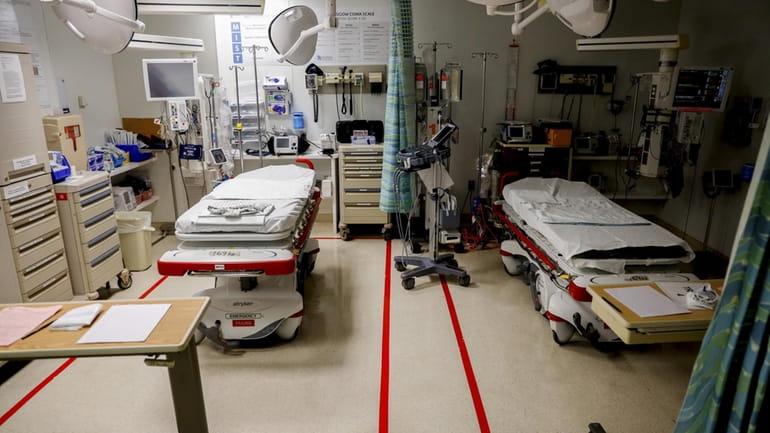COVID deaths plummet in 2023 on Long Island, in New York, U.S.

A trauma room at Mount Sinai South Nassau hospital in Oceanside in May 2020. COVID deaths on Long Island have fallen each year since then. Credit: Newsday/Jeffrey Basinger
COVID-19 deaths plummeted in 2023 on Long Island, with three times fewer people dying last year than in 2022, and eight times fewer than in 2020, state data shows.
Annual Long Island COVID deaths are now in the hundreds — 657 in 2023 — compared with the thousands in the past. Deaths also fell sharply statewide and nationwide.
Experts said a less lethal virus, better treatments and immunity acquired from vaccinations and previous coronavirus infections are driving the decrease.
“There's no comparison to 2020 in any way, shape or form,” said Dr. Bruce Farber, chief of public health and epidemiology for Northwell Health. “The virus was new. There was no therapy. There was no immunity. It was much more virulent.”
WHAT TO KNOW
- COVID-19 deaths fell sharply between 2022 and 2023 on Long Island, statewide and nationwide.
- On Long Island, there were 657 COVID-19 deaths between Dec. 31, 2022, and Jan. 2, 2024, compared with 2,001 between Jan. 1 and Dec. 30, 2022, and 5,299 in 2020, according to state data, which does not include deaths in places like private homes and hospices.
- Experts say a less virulent virus, more effective treatments and immunity obtained through vaccinations and previous infections led to the drop in deaths.
Since 2020, the virus has continued to mutate to become less virulent, but more transmissible, which is why many people are getting sick with COVID-19 this winter, but fewer are sick enough to require hospitalization, said Stephanie Silvera, a professor of public health at Montclair State University in New Jersey.
From Dec. 31, 2022, to Jan. 2, 2024, 334 people died of COVID-19 in Nassau County and 323 in Suffolk County, according to the state Department of Health, which no longer reports death data on weekends and holidays.
That’s down from 1,006 deaths in Nassau and 995 deaths in Suffolk from Jan. 1 to Dec. 30, 2022, and 1,214 in Nassau and 1,476 in Suffolk in 2021.
In 2020, there were 2,942 deaths in Nassau and 2,357 in Suffolk.
Those numbers include only deaths in hospitals, nursing homes and adult-care facilities but not places like private homes, hospices or prisons.
Statewide, there were 4,062 COVID-19-related deaths from Dec. 31, 2022, to Jan. 2, 2024, compared with 11,910 from Jan. 1 to Dec. 30, 2022, and 30,208 in 2020.
Centers for Disease Control and Prevention data, which is based on death certificates but is incomplete for 2023 because of reporting lags, shows similar, sharp drops in COVID-19 deaths for Nassau, Suffolk and the state.
Immune systems better equipped
The annual COVID-19 death numbers likely will continue to fall each year, Silvera said. But, just like with the flu, “there may be some years when there is a [virus] strain that is particularly virulent and causing greater death,” she said.
Dr. David Dowdy, a professor of epidemiology at Johns Hopkins University in Baltimore, said people’s immune systems are better able to handle a COVID-19 infection because of vaccination and previous infection. A study released in June showed that by mid-2022, almost all Americans had COVID-19 antibodies from vaccination, infection or both.
When COVID-19 was new to the body, the immune system sometimes overreacted, and that sometimes led to inflammation and other problems that caused severe illness or death, Dowdy said.

People’s immune systems are better able to handle a COVID-19 infection than in the past, said Dr. David Dowdy, professor of epidemiology at Johns Hopkins University. Credit: Chris Hartlove
Now, he said, the immune system can recognize the virus and respond to it in a more measured way, so there’s a lower risk of “the kind of serious reaction that's going to lead to severe hospitalization and death."
Even those who get sick enough to be hospitalized because of COVID-19 “are not as sick as they were before,” Dowdy said.
Farber said that in Northwell hospitals, “there are very few people in intensive care units due to COVID. The overwhelming majority of people who come into the hospital with COVID get better and leave.”
Medications such as remdesivir that were not approved for treatment of COVID-19 until months into the pandemic have saved lives, he said.
Those who get severely ill or die of COVID-19 always have disproportionately been older adults. But, Dowdy said, that’s even more true today, when, for example, the gap between the death rates of a 45-year-old and a person 70 and older is far wider than two years ago. Even with the advances, older people are more vulnerable because of weaker immune systems, he said.
Hospitalizations rising over holidays
Although deaths are down significantly over the past few years, more people have been hospitalized with the disease over the past several weeks than before Thanksgiving.
COVID-19 hospitalizations on Long Island nearly tripled between Dec. 1 and Wednesday, from 229 to 661, before declining slightly on Thursday to 653, state data shows.
But that is significantly below previous numbers in early January, which each year has been the peak of hospitalizations during the annual late fall and early winter COVID-19 surge.
On Jan. 3, 2023, there were 912 hospitalizations on Long Island, the highest number for the year. On Jan. 11, 2022, the peak for that year, there were 2,254. The highest number of hospitalizations during the pandemic was on April 10, 2020, when 4,108 people with COVID-19 were hospitalized on Long Island.
The drug Paxlovid, which is taken shortly after symptoms emerge, is keeping many high-risk people out of hospitals, Silvera said. The federal government authorized its use in December 2021.
The number of confirmed COVID-19 cases also increased sharply on Long Island and statewide in the past several weeks, state data shows, but experts caution that those numbers are huge underestimates, because most tests are now performed at home and results are not reported to the state, and many people don’t test if they feel sick.
Wastewater samples, used to detect the presence of COVID-19, show high levels on Long Island, according to state data.
Dr. Susan Donelan, medical director of health care epidemiology at Stony Brook Medicine, said the post-Thanksgiving rise in cases and hospitalizations is not a surprise. The increase in indoor interactions and activities, as well as travel, helped facilitate the spread of COVID-19, the flu and other respiratory viruses, she said.
COVID deaths in flu territory
The number of COVID-19 deaths is now roughly in the upper range of annual flu deaths, which between 2010 and 2022 were between 4,900 and 52,000 fatalities nationwide each year, except for the 2020-21 flu season, when there were very few flu cases amid early COVID-19 restrictions, the CDC says.
In 2023, there have been 45,621 COVID-19 deaths nationwide, CDC data shows. The 2023 numbers are provisional and incomplete, the agency notes. They are based on death certificates, which can take weeks to arrive at the CDC and then be analyzed.
Still, the nation is on track to have far fewer deaths than the 186,555 provisional number of COVID-19 deaths in 2022, and the 416,893 deaths in 2021, the peak year nationwide for COVID-19 fatalities.
Any tally of COVID-19 deaths is imperfect, experts said.

A lab technician prepares samples at a Northwell Health lab in New Hyde Park in November. Credit: Northwell Health/Marc Farb
The CDC’s numbers are based on death certificate information supplied by the state, in which COVID-19 is listed as the underlying or contributing cause of death. But there's often uncertainty as to the precise cause of death, Dowdy said.
The death numbers the state posts on weekdays are more up to date than the CDC's death certificate numbers, because they come from electronic reporting from health care facilities. But they exclude deaths outside those facilities and they are based on where the person died, not where the individual lived. The criteria for deciding which deaths are counted as COVID-19 fatalities are different for hospitals and nursing homes, according to the state health department.
Dowdy said the declining death rate doesn’t negate the importance of getting an updated COVID-19 vaccine, especially for those with weakened immune systems. Even for younger, healthy people, vaccination reduces the severity of illness and the chance of transmission to others, he said.

